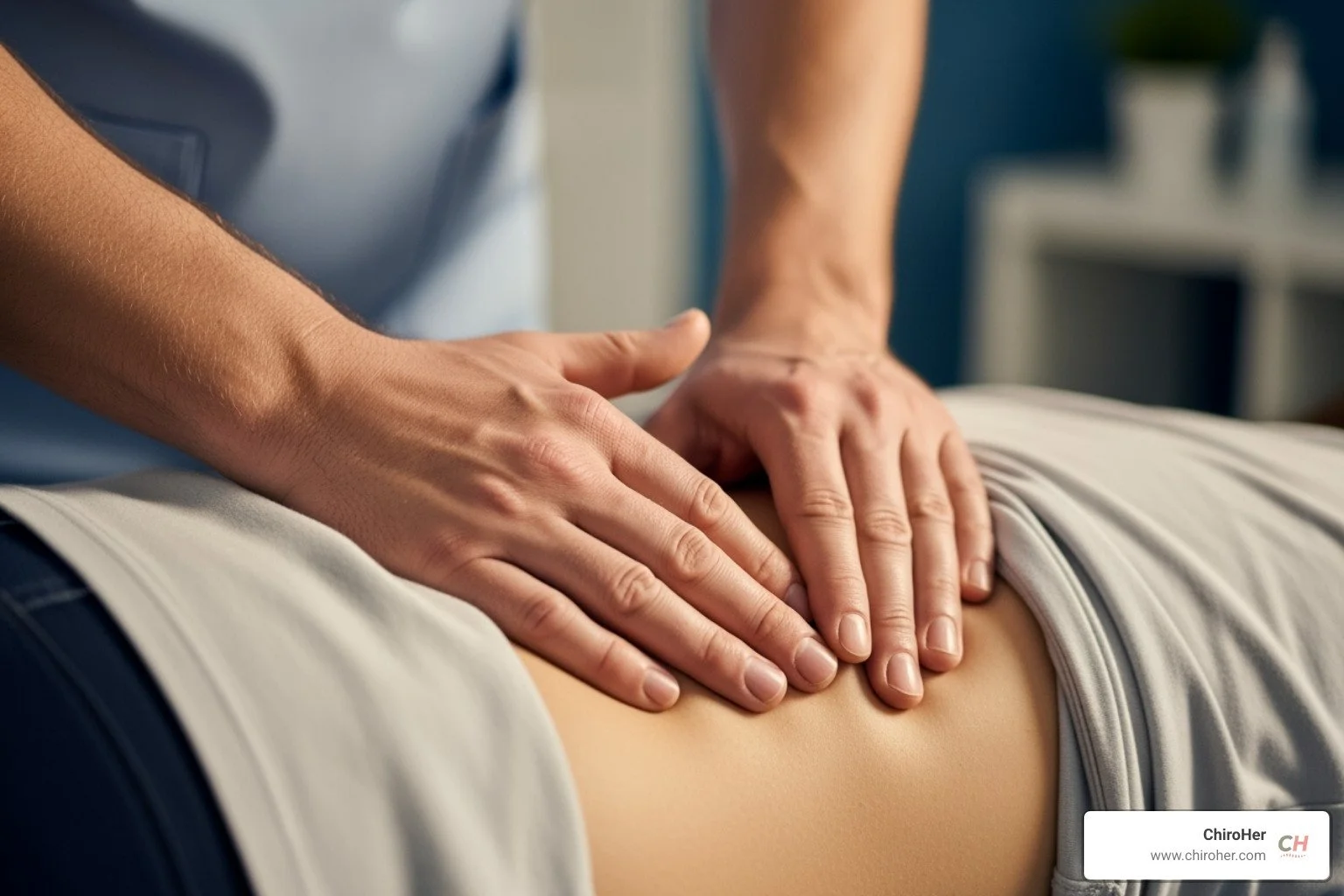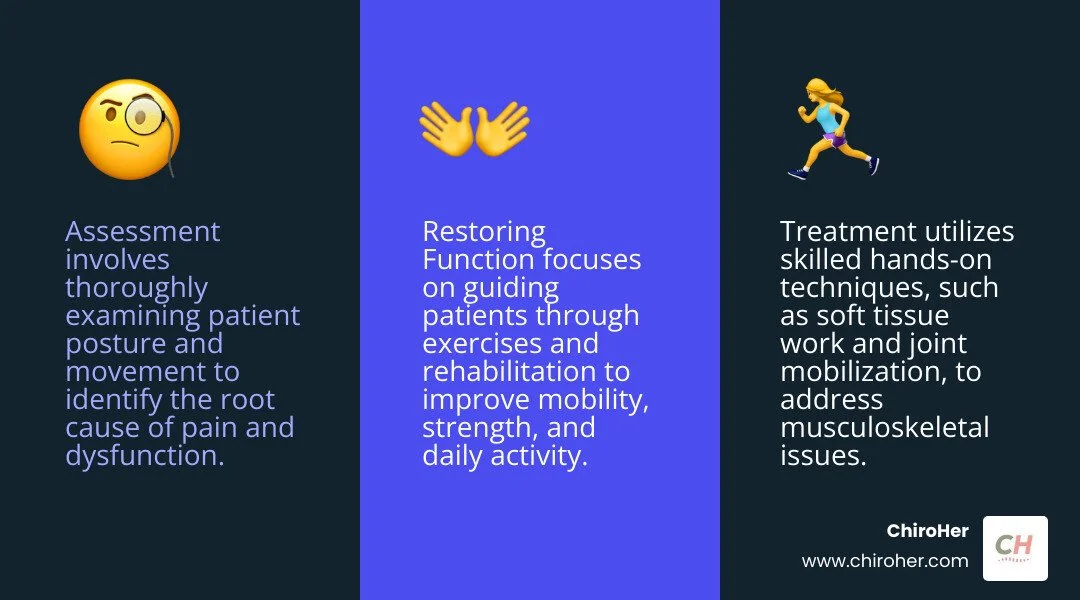A Comprehensive Guide to Manual Therapy
What is Manual Therapy?
Manual therapy is a specialized form of hands-on treatment that uses skilled techniques to diagnose and treat musculoskeletal pain and dysfunction. This approach involves trained practitioners using their hands to manipulate muscles, joints, and soft tissues with the goal of reducing pain, improving mobility, and restoring normal function.
Quick Answer: The Basics
Definition: Hands-on treatment using skilled techniques to address pain and movement problems
Who provides it: Physical therapists, chiropractors, and other trained healthcare professionals
Main goals: Reduce pain, increase joint mobility, improve function, reduce inflammation
Common conditions treated: Back pain, neck pain, arthritis, whiplash, TMJ, sciatica, sports injuries
Safety: Cost-effective with low risk of serious complications - similar safety profile to exercise
Hi! I'm Dr. Michelle Andrews, founder of ChiroHer in Oklahoma City. I've spent years using manual therapy to help women find relief from pain and improve their quality of life. My training in prenatal chiropractic care and sports recovery has shown me how these hands-on approaches can make a real difference.
Defining Manual Therapy and Its Goals
At its core, manual therapy is about the skilled application of our hands to help your body heal and move better. It is practiced by a variety of healthcare professionals with specialized training, including physical therapists, osteopaths, and chiropractors like us. The primary goals are to:
Reduce pain and discomfort
Increase joint mobility and range of motion
Improve the health of soft tissues
Reduce muscle tension and inflammation
Facilitate better movement patterns
Improve overall function and quality of life
Manual therapy is incredibly versatile and can benefit many conditions, including arthritis, whiplash, TMJ dysfunction, sciatica, sports injuries, chronic back and neck pain, and headaches. If a musculoskeletal issue is causing you discomfort, manual therapy is often a crucial part of the solution.
For a deeper understanding, you might find this resource on An overview of Orthopaedic Manual Physical Therapy insightful.
Manual Therapy vs. Other Hands-On Approaches
While manual therapy and general massage both involve touch, their goals and methods are distinct. Our approach with manual therapy is rooted in diagnosing and treating specific muscle or joint conditions. We use a thorough physical examination to pinpoint the source of your pain or limited movement.
In contrast, massage therapists typically focus on overall well-being, stress reduction, and general muscle relaxation. A key difference is the integration with exercise. We often combine manual techniques with prescribed therapeutic exercises to create a multimodal program that yields the best outcomes. The manual work provides immediate relief, creating a window of opportunity for exercises to strengthen and stabilize the area for lasting results.
Here's a quick comparison:
Feature Manual Therapy (Chiropractic/Physical Therapy) Massage Therapy (General) Primary Goal Diagnose & treat specific musculoskeletal dysfunctions; restore function Promote relaxation, reduce stress, general muscle tension relief Techniques Joint manipulation, joint mobilization, soft tissue mobilization, MET, MFR, ART Swedish, deep tissue, hot stone, sports massage, relaxation techniques Focus Correcting underlying structural/neurological issues; improving specific mobility General muscle health, circulation, lymphatic drainage, stress reduction Diagnostic Role Integral to assessment and treatment planning Generally no diagnostic role Integration Often combined with therapeutic exercises and patient education Can be complementary; sometimes integrated with chiropractic care Conditions Back pain, neck pain, sciatica, TMJ, whiplash, specific joint restrictions Muscle soreness, stress, anxiety, general stiffness
The Techniques and Science Behind Manual Therapy
Manual therapy is a sophisticated practice grounded in an evidence-based approach. Our techniques are supported by a scientific understanding of how the body works and responds to touch, especially when integrated with other modalities like therapeutic exercise.
Common Manual Therapy Techniques Explained
Manual therapy includes a range of techniques, each designed to address specific issues. Here are some of the most common ones we use:
Soft Tissue Mobilization: Applies pressure and stretching to muscles and ligaments to release tension, break up scar tissue, and improve circulation.
Myofascial Release (MFR): Uses continuous, moderate pressure to release restrictions in the fascia (connective tissue), improving flexibility and reducing pain.
Trigger Point Therapy: Involves applying sustained pressure to specific muscle knots (trigger points) to reduce local and referred pain and restore normal muscle function.
Joint Mobilization (Non-Thrust): Uses slow, controlled movements of a joint to improve flexibility, reduce stiffness, and decrease pain.
Joint Manipulation (Thrust): A quick, precise movement applied to a joint to restore normal motion. It is often associated with a "pop" or "crack" and can be effective for lower back pain and stiff joints.
Muscle Energy Technique (MET): Uses your own gentle muscle contractions against resistance to improve joint mobility and lengthen shortened muscles.
Strain-Counterstrain: A gentle technique that involves passively positioning your body in a pain-free direction to allow overactive muscles to relax and reset.
These techniques are powerful tools that allow us to address the unique needs of each patient. For more information, you can explore scientific research on Muscle Energy Technique for low-back pain.
How Does It Work? The Science Behind the Touch
While traditional explanations focused on biomechanical corrections, modern research reveals a complex interplay of neurophysiological, psychological, and contextual factors.
Biomechanical and Neurophysiological Effects
Manual therapy works on two main levels: mechanically restoring motion and neurologically calming the nervous system.
Restoring Motion: By mobilizing or manipulating joints and soft tissues, we can improve range of motion, reduce stiffness, and lengthen tight muscles. This can also improve fluid dynamics in joints, which is associated with pain relief.
Quieting the Nervous System: The most compelling effects are neurophysiological. Manual therapy can influence how your nervous system processes pain. It can stimulate nerve fibers that block pain signals, decrease your overall pain sensitivity, and reduce inflammatory markers. Research also shows it can trigger the release of your body's natural painkillers (like endorphins) and change how your brain processes pain signals.
The Role of Context and Therapeutic Alliance
Beyond the physical changes, the human element plays a huge role. Your belief in the treatment's effectiveness (patient expectations) and the positive relationship you build with your practitioner (therapeutic alliance) are powerful factors that can influence outcomes, especially in chronic pain conditions. We strive to create a warm, supportive environment where you feel heard and understood, as this is a key part of the healing process.
For a comprehensive look at these mechanisms, we recommend exploring a model for the mechanisms of manual therapy.
Is Manual Therapy the Right Choice for You?
Wondering if manual therapy could help with your pain or movement issues? The good news is that it can benefit a wide range of conditions, and we're here to guide you. The beauty of manual therapy lies in its personalized approach. Whether you're dealing with chronic back pain, recovering from an injury, or experiencing pregnancy-related discomfort, we'll work together to create a treatment plan that makes sense for you.
What to Expect During Your Session
Walking into our clinic for your first manual therapy session should feel welcoming. We've designed our process to be thorough yet comfortable.
Consultation and Examination: We begin with a conversation about your health history, symptoms, and goals. This is followed by a comprehensive physical examination where we observe your movement, test your range of motion, and feel for areas of tension or restriction.
Personalized Treatment Plan: Based on our findings, we develop a plan specifically for you. We'll explain which manual therapy techniques we believe will be most helpful and why, ensuring you feel confident about the approach.
Hands-On Treatment: During the session, we'll apply the specific techniques we've discussed. Throughout the treatment, we encourage open communication to ensure your comfort.
Post-Treatment Care and Exercises: After your session, we'll provide guidance for the next 24 hours, which usually includes staying hydrated and avoiding strenuous activities. We'll also give you specific therapeutic exercises to do at home to reinforce the benefits of your treatment and help you achieve lasting results.
Safety, Contraindications, and Finding a Provider
Is manual therapy safe? Yes, it has an excellent safety record. The risk of serious adverse events is extremely low, similar to the risk associated with regular exercise. It is also a cost-effective treatment for musculoskeletal pain.
When to Be Cautious
While safe for most people, there are situations (contraindications) where we need to be cautious or modify our approach. These include recent fractures, severe osteoporosis, active infections or tumors in the treatment area, open wounds, or certain vascular and neurological conditions. We always perform a thorough screening to ensure your safety.
Finding the Right Practitioner
Choosing the right provider is key. Look for practitioners with proper qualifications, such as a clinical doctorate and a current license. At ChiroHer, our team specializes in women's health and prenatal care, and we've built our reputation on award-winning, patient-focused care in a comfortable, upscale environment.
If you're in the Oklahoma City area, including Yukon, Edmond, or Mustang, we invite you to see if our approach is right for you. Learn about our approach to personalized care or get more info about our chiropractic services.
Building Trust: Authority and Evidence in Manual Therapy
When you're considering manual therapy, you deserve to know that your treatment is backed by solid science. At ChiroHer, we believe transparency about our methods helps you feel confident in your care.
Evidence-Based and Always Learning
Every technique we use is grounded in research and clinical evidence. Studies consistently show that manual therapy is effective for musculoskeletal conditions, especially when combined with therapeutic exercises. We don't guess—we apply knowledge that has been tested and validated.
Healthcare is constantly evolving, which is why our team makes ongoing education a priority. This commitment means you're always receiving care that reflects the most current understanding of how manual therapy works and which techniques are most effective.
Trusted Resources and Scientific Backing
We encourage you to explore the research behind manual therapy from reputable organizations. These resources demonstrate that manual therapy is evidence-based healthcare recognized by major medical institutions.
American Physical Therapy Association - Manual Therapy: Provides insights into evidence-based practices.
National Institutes of Health - Complementary Health Approaches: Offers comprehensive information on various manual therapies.
Our dedication to providing the highest quality care means we never stop learning. You can trust that your treatment plan is based on the latest scientific evidence and delivered with genuine care for your well-being.
This guide is for informational purposes and is not a substitute for already established medical advice from your healthcare provider.




